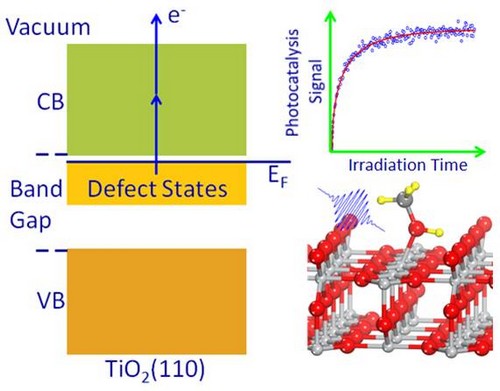Recently, Prof. Xueming Yang has been invited to write a review entitled “Surface Photochemistry Probed by Two-Photon Photoemission Spectroscopy” for Energy & Environmental Science (Energy Environ. Sci.,DOI: 10.1039/C2EE21493H). In this article, the application of two-photon photoemission spectroscopy (2PPE) in the study of surface photochemistry was briefly reviewed, the mechanism of photocatalyzed splitting of methanol on TiO2 single crystal surface was described in detail, and the combination of 2PPE and other surface science techniques in studying the dynamics of surface photocatalysis was proposed.
2PPE is a powerful tool in investigating the electronic structure and dynamics of excited state on metal and metal oxide surfaces and interfaces. Two-photon absorption is realized by using the high peak power laser, especially femtosecond laser. The first photon excites an electron from below the Fermi level to above it, and then the second photon photoemits it above the vacuum level. The energy and angular distribution of the photoelectrons give rise to the 2PP spectra. As it works in the (1+1) pump-probe style, 2PPE can be applied to measure the lifetime of the excited state and the relaxation and transfer of charge carriers, which can’t be realized using conventional one-photon photoemission spectroscopy such as ultraviolet photoemission spectroscopy (UPS) and X-ray photoemission spectroscopy (XPS). Since the changes of electronic structure accompany the surface chemical reactions, tracing the evolution of the electronic structure can monitor the kinetics of surface reactions.
In the past few years, researchers in group 1102 led by Prof. Yang built a time-resolved femtosecond two-photon photoemission spectroscopy apparatus, developed the time-dependent 2PPE method in studying the kinetics of surface photochemistry and photocatalysis and applied firstly this method to explore the mechanism of photocatalytic reactions on TiO2 surface. The ROH/TiO2 systems are highly related to energy and environmental science. Prof. Yang and coworkers studied the kinetics of photochemistry of water and simple alcohols on rutile TiO2(110) in detail and important progress has been made. Some of their results were published in Chemical Science (http://pubs.rsc.org/en/content/articlelanding/2010/sc/c0sc00316f, http://pubs.rsc.org/en/content/articlelanding/2011/sc/c1sc00249j). Among them, the photocatalyzed splitting of methanol on TiO2(110) was the first mechanistic study of the photochemistry of methanol on single crystal TiO2 surface(Surf. Sci. Rep. 66, 185). It was highlighted by Science (http://www.sciencemag.org/content/330/6000/12.1.full?sid=4fd94f95-7d03-4ec6-876e-1bfc31224cf5), and selected as Cutting Edge Chemistry in 2010 by Chemistry World(http://www.rsc.org/chemistryworld/News/2010/December/21121001.asp).
Though the application of the 2PPE technique in the study of surface photocatalysis has just begun, it has already shown a great potential for investigating important photocatalytic chemistry problems on metal oxides.2PPE is a technique to probe surface excited electronic structures and their changes in photocatalytic processes. It is important to emphasize that the combination of the 2PPE technique with other sophisticated methods for photocatalytic studies such as TPD mass spectrometry and STM could be an even more powerful approach to unraveling the mechanism of complex surface photocatalytic processes. Applying ultrafast IR light sources in the study of surface photocatalysis could help us to understand important aspects of surface photocatalytic processes, such as the influence of vibrational excitation of adsorbates in photocatalytic reactions. Furthermore, new ultrafast pump-probe methods using 2PPE as a probe are also desirable in looking at photocatalytic processes in real time. All these development could further help us to better probe the complex photocatalytic processes on metal and metal oxide surfaces. (Reported by Chuanyao Zhou & Dongxu Dai, Group 1102).
